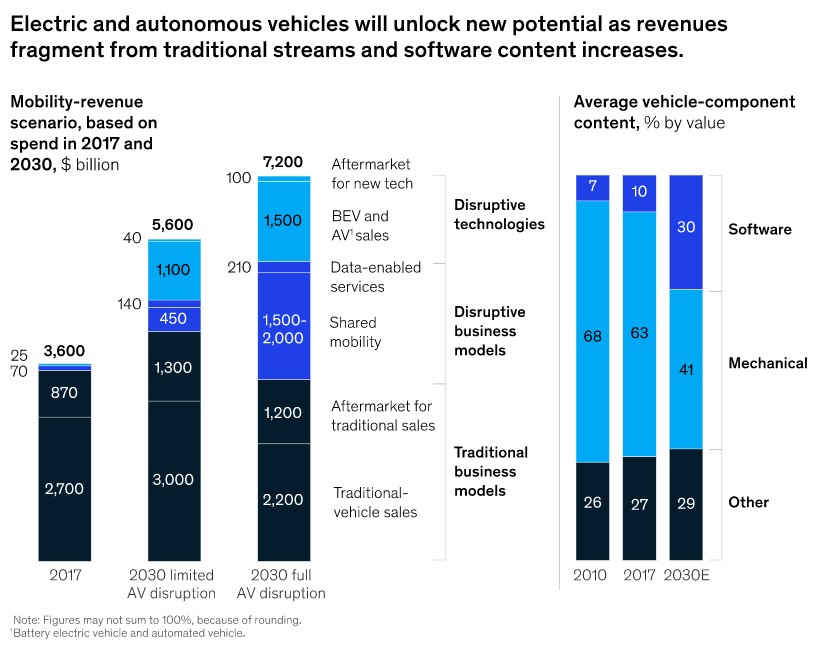A journalist rode in a driverless vehicle last week. The tricked-out minivan navigated busy city streets, made an unprotected left-hand turn and even reached speeds of 45 mph.
There wasn’t a safety engineer aboard for the ride. According to a TechCrunch report, it was a completely uneventful, yet remarkable ride in a Waymo fully autonomous vehicle.
It’s a glimpse of the future. Investors should pay attention.
Related post: GM’s costly ride-sharing fiasco highlights Waymo’s genius
Self-driving vehicles reached peak hype a year ago. Every major technology company, even Apple (AAPL), seemed to be working on a project.
The auto shows were full of extravagant concepts with flat screens and lounge seating. Many prototypes didn’t even have steering wheels. The sleek glass and ultralightweight designs made the idea seem so far off in the future, like some Sci-Fi film.
Related post: This limo is like a five-star hotel without a maid … or driver
This year, autonomous vehicles are taking the wheel.
Waymo has been on the self-driving trek for a decade …
As a unit inside Alphabet (GOOGL), the research began when Sergey Brin, Google’s co-founder, splintered off a handful of gifted engineers to work out the math for vehicle automation. By 2012, Brin was promising an operational vehicle by 2017.
It turned out Brin was right, sort of.
In 2015, Steve Mahan, who is legally blind, became the first rider in a fully self-driving car on public roads. He was grinning ear-to-ear as the test car zipped along the streets of Austin, Texas, using sensors to navigate through intersections and around pedestrians.
Technology put Mahan alone in a moving car for the first time in 12 years. But it did not come cheap.
The extent of these costs first showed up in 2016 when Alphabet began breaking out the line item expenses for its peripheral investments. The company spent a whopping $3.5 billion on so-called moonshots during 2015 … an 83% increase over 2014.
Ruth Porat, Alphabet’s chief operating officer, was sanguine when questioned about the investment in self-driving cars. As a veteran of investment banking, she understood the potential payoff.
Automation is not only about watching Netflix (NFLX) or sipping cocktails during the evening commute. The big opportunity is changing the business models centered around transportation.
Most passenger vehicles are parked 95% of the time, according to a research paper from Donald Shoup, a professor of urban planning at UCLA. This means most of the time vehicles are in your driveway, or parked at shopping centers or outside at work. Increasing use, even marginally, is a big business opportunity.
Taxis and ride-sharing increase utilization rates. However, the golden goose is autonomy.
Related post: Uber Works: The killer app of the gig economy
If cars and light trucks were functionally autonomous, there would be no need for individual ownership.
- Passengers could hail a vehicle with their smart device, set the destination and pay for the service without any human intervention.
- Killing ownership would also kill the cost of maintenance, fuel and insurance, not to mention the cost of professional drivers.
The evolution of this model should be extremely negative for automakers and their suppliers, energy and insurance companies.
On the other hand, McKinsey & Co., a global business management company, expects the shift to autonomous robo-taxis could be a $1.5 trillion-$2 trillion opportunity.
This is a business segment that does not currently exist.
The Wall Street Journal reported in March 2018 that Waymo ordered up to 20,000 Jaguar electric SUVs for its driverless fleet. Two months later, the company announced plans to add an additional 62,000 Fiat Chrysler minivans.
One of those vans was at the center of the TechCrunch story last week.
Ed Niedermeyer, a writer at the online news site, explained that an empty Pacifica minivan navigated to his location near a park in Chandler, Ariz.
A message in his Waymo One app indicated the ride would be different because there was no one up front; Waymo would do all the driving.
After buckling up, the vehicle automatically called a member of the Waymo rider assistance team, just to make certain there were no immediate concerns.
Then the trip began.
With the exception of a few overcautious moments, Niedermeyer noted it was hard to tell the vehicle was not being driven by a human.
Saswat Panigrahi, the director of product at Waymo, says the autonomous driving program has completed 10 million real-world miles and another 10 billion under simulation.
For now, all driver-free rides in Arizona will only occur in specific geofenced sections of Chandler, Mesa and Tempe. And Waymo is still clearly a work in progress. Panigrahi admits to working out the bugs for protocols for emergency vehicles, like pulling over or relinquishing control.
Related post: 5G will change your life … and maybe even save it
However, investors need to be aware these small issues can be resolved, and that fleets of autonomous robo-taxis will happen sooner than later.
It’s a big shift that often does not make it to the top of newscasts. However, it’s happening.
Best wishes,
Jon D. Markman


